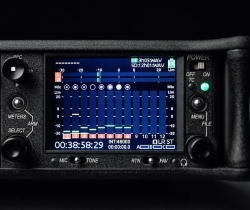
Sound Devices and Dan Dugan Sound Design announce that the Sound Devices 688 mixer/recorder will be offering Dugan automixing as part of its Firmware Version 3.00 update, available at no cost to 688 owners upon release next week at NAB 2016.
On the market for less than a year, the 688 will be on display at Booths C6040 and C6706, respectively, featuring Dugan’s well-known automatic mic mixing. In keeping with Sound Devices’ commitment to giving production sound mixers the tools they need to help them mix in increasingly complex production settings, the inclusion of the Dugan Speech System, along with Sound Devices’ MixAssist, makes the 688 the ‘go-to’ automixing tool for field production applications.
“This collaboration brings together the durable, professional-grade audio equipment Sound Devices is known for and the well-respected Dan Dugan automixing algorithm,” says Jon Tatooles, chief business development officer, Sound Devices. “We’re proud to be the first and only field production mixer that offers Dugan automixing. Adding automixing from an industry powerhouse like Dan Dugan Sound Design enhances an already-great product.”
“Dugan automixing takes over the nerve-wracking job of cueing mics in and out, freeing up the location recordist to pay more attention to the artistic balance,” says Dan Dugan, CEO, Dan Dugan Sound Design. “Mixes are cleaner and post-production time is reduced for dramatic dialogue recording. In addition, over-the-shoulder recordists for news, documentaries and reality shows will appreciate how my automixing makes it possible to use several mics at once without background noise build-up. I’m pleased to license Dugan automixing for inclusion in this excellent product from Sound Devices.”
Getting a great production mix can be challenging in many field applications. Unscripted dialog, multiple characters, and wide-and-tight multi-camera coverage often require the use of wireless lavalier mics and multi-track recording. In these situations, automixers improve intelligibility, reduce noise and reverberation, and maintain consistent overall gain as microphones are turned on and off.
Dugan automixing is widely used in broadcast television applications, in dialog recording for TV and motion picture production, and in house of worship (HOW) applications. It also is a good choice for teleconferencing, video trucks, and theater applications with multiple wireless microphones on stage.
“Many front of house and live broadcast mixers are familiar and comfortable with Dugan automixing, and how it sounds,” adds Tatooles. “We added Dugan to the 688 mixer/recorder because it’s a great option. Both Dugan and our MixAssist algorithms have the same goal — attenuating unused microphones to reduce background noise and the likelihood of feedback. The way they do it differs. There are subtleties that may steer a user to one method over another. The inclusion of Dugan automixing gives the sound mixer a choice, situation dependent, on which automixing tool best suits their application.”
MixAssist from Sound Devices can be used for mixing many speech-specific applications, including reality TV productions; a variety of broadcast TV programs, such as game shows, debates, and panel discussions; wireless multi-mic dialogue recording for TV and motion picture production; sound applications for various corporate needs; HOW capture; and more.
Sound Devices is committed to the continual improvement of existing feature sets. In addition to the Dugan inclusion, the Firmware v3.00 update also enhances Sound Devices’ MixAssist automixing feature with the ability to adjust the amount of attenuation applied to inactive/closed-mic sources. This allows the end user to tweak MixAssist to find the sweet spot between optimal noise reduction and smooth-sounding mix in different production environments.
The 688 features six high-bandwidth mic/line XLR inputs, each complete with phantom power, high-pass filter, analog input limiter and variable pan, plus six additional line-level TA3 inputs for added flexibility in complex productions. All inputs are assignable, pre- or post-fade, to eight-output buses: left/right plus Aux 1-6. The main left/right mix is available to three outputs simultaneously via transformer-balanced XLR and Hirose outputs.
For recording, the 688 offers 16-track, polyphonic, or monophonic broadcast WAV and MP3 file recording to SD and CompactFlash cards. All common sampling rates are supported, including 192 kHz on up to six tracks. The 688 features comprehensive metadata editing, sound report creation, an Ambient timecode generator and reader, a two-second, power-on-to-record ability called QuickBoot, and PowerSafe, a built-in, 10-second power reserve to protect against data loss from inadvertent power loss.
